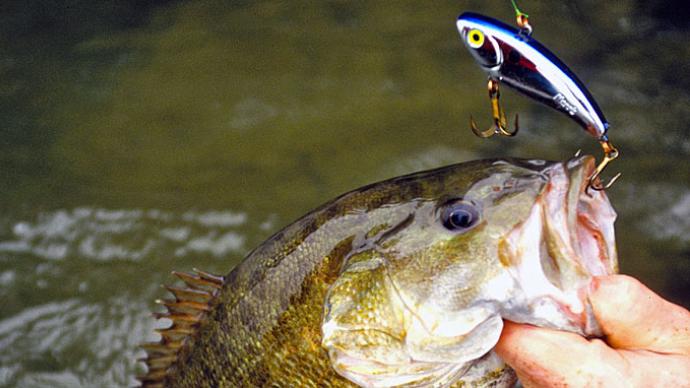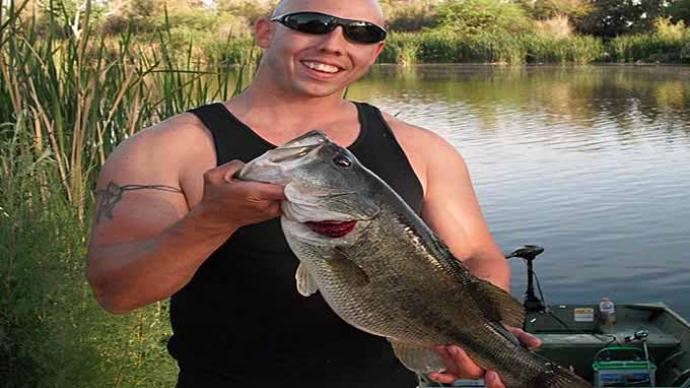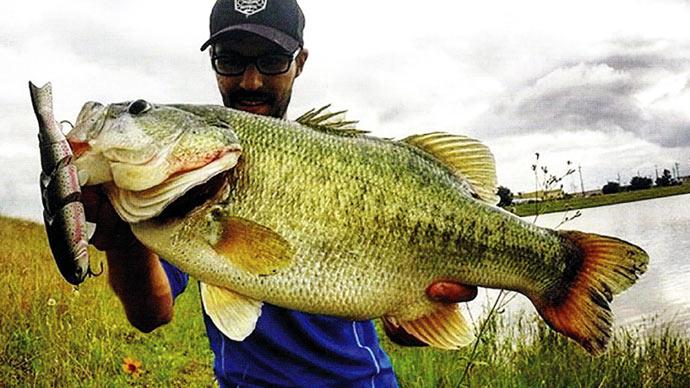
I grew up in a time and place where the option for fishing for bass was limited primarily to smaller private ponds or lakes. The larger lakes in East Texas usually consisted of some oxbows off of the Red River or one of its tributaries. Other options were the water supply bodies built to serve local communities, which were, at best, a couple of hundred acres, smaller farm ponds, or a trek to Caddo Lake. The latter was always a special treat just for the scenery.
My game plan was to catch fish, and like most fishermen at the time in the area, this usually meant using live bait on a cane pole, with the quarry being bass, crappie, or anything else with fins that happened to get on the hook. I tried to occasionally use a six-inch long Lucky 13 on my Bronson Altoona casting reel (complete with a solid glass rod). I occasionally caught a berserk bass that did not mind tackling a bait almost as big as the fish. This was a purist's approach to catching bass that was not held in much respect by the older fishing crowd that my dad fished with since the minnow approach was much superior in numbers and the amount of daytime you could catch fish. My overgrown topwaters were decidedly disadvantaged at any time except for a narrow time window at dawn and dusk.
Now don't jump to the conclusion that the fishing crowd did not have their specifications for the bait they used. A bass fisherman wouldn't be caught with anything less than a bait close to filet size. Likewise, many of the crappie folks would want the smallest of the minnows for their prey. This made for some interesting counting for the selected dozen since the supplier was not blessed with a truck full of bait grown in a hatchery but rather whatever got in the seine of the guy with the minnow vat.
I learned from my minnow dunking days that a wide array of sized bass could be caught on minnows while only larger fish fell prey to my floating log with hooks. Then the light shone through in the form of my first closed-face spin-cast reel. It got me into some real trouble with several of the older guys when I rigged it with a slip cork and could accurately pitch to areas considered beyond their presentation reach with the cane poles. The first accusation was that I would be hung up all day, and they would have to waste valuable time paddling over to get me off the brush.
The actual problem occurred when "the kid" caught more fish due in large part to the fact that the grownups did not have a prayer of getting their bait to as many spots as I was able to work while we were sitting in the same boat. This lesson registered to this day: if you stay in one spot and the fish are not there, you have to wait for them to come to you. If you cover more water in a selected approach, you find the fish.
It did not take long to figure out that the spincast could cast much smaller plugs than those I had used on the level wind reel. A friend's dad made the first cloth pen spinner bait about this time and called it a Skippy. You could throw this creature a mile, and it could be fished at various depths by simply slowing down the retrieve rate. It opened up a whole new concept of fishing for bass during midday when the top water was less efficient. There surely would not be a bass in any farm pond in Lamar or Red River County that was safe anymore. If there was such a bass, the introduction of the plastic worm by Mr. Nick Creme took care of completing the sweep.
This combination of events removed me forever from the minnow-dunking fraternity and shoved me into the realm of the bass purist. Moreover, the combination of these experiences on small ponds greatly influenced how I fished when big lakes appeared and my strategy for catching bass on the "giant" reservoirs.
Some interesting observations were made during the snake-and-chigger visiting days of my farm pond era. To begin with, the bass in these smaller bodies were skittish, and a quiet approach worked best in presenting the bait. I still firmly believe this when fishing shallow water in a large lake. The small ponds were stocked with native bass since Florida bass and hybrids were on down the road, and fortunately, no one had heard or cared about grass carp. The most productive of the farm ponds were those with clearer water and vegetation. The least productive for bass were the ones that stayed muddy and bare-bottomed. A lot can be learned from observations when a smaller pond is drained. It confirmed my suspicion, which was based on fishing in such ponds. Suppose they are not managed properly by having an appropriate balance of food, fish, and game species. In that case, the game species will eventually be represented by a few larger fish but primarily small, skinny ones.
Another gem learned from years of fishing small waters was that a five-or six-pound bass was a large fish. We now have Florida strains or crosses of such fish in the large public impoundments and private lakes. So we have grown accustomed to hearing stories of eight-pound fish as commonplace in Texas waters. However, some of the best-trained fisheries biologists carefully manage numerous privately owned small impoundments across our state. I have been privileged to fish in some of these lakes, and the difference between these and public waters is that the balance of the fish populations is easier to control. Because of their smaller size, corrective action can be taken easier to improve water quality by various lake treatments as necessary to produce the most productive aquatic environment. The other given is that the folks who own these bodies of water put some appreciable dollars into managing them. So the result of this attention is that the overall bass population in such a lake usually has well-proportioned bodies regardless of age group.
There does seem to be another issue associated with small bodies of water: some governance as to the maximum growth potential of a bass. When the balance of fish-per-acre gets off course, stratification of sizes in the population seems to occur, and at least one explanation is the lack of food for specific year groups. However, that is not a big problem with the privately managed lakes in that there are controls ranging from selective harvest to the actual infusion of threadfin shad as determined to be needed.
So why do we not have new state and national records from one of these well-managed private waters? Indeed, there has been an adequate time since folks started trying with an infusion of Florida bass and well-controlled environments. This is precisely what I felt would happen when we began to have Florida bass available for stocking in private lakes. These fish have everything provided to them to have someone see they have plenty to eat. Yet, even with the good life, these sources of bass have yielded only a few unique contributions to the top 25 largest bass in Texas (two from Echo Lake), while the vast number of the top bass come from public waters. It sure is not from the lack of trying to create giant bass or due to the limit to the number of sites where close control of the bass population is occurring in private water. Don't get me wrong, privately managed lakes produce great fisheries with numerous bass of nine+ pounds, but so does Lake Fork. The difference between these private and public waters is usually in the quantity and average quality of the individual bass. The fact remains based on the current records. You cannot put a bass in a bathtub, force food down it, and grow a new record bass.
Let's talk about a game plan required to fish small waters. The difference in the productivity of my large Lucky 13 and the many other choices that the spin cast reel let me cast is based on several factors. First, I could use lighter and smaller baits, which lets you get more strikes and catch more fish in any setting. The next is that you must be able to fish different strata of the lake or pond. Finally, at times the fish will be locked into a feeding pattern similar to those in a large lake where your best bet is for a presentation on the bottom, whereas on other days, the fish will hit shallower worked bait.
I had mentioned the topwater as representing my earlier experiences with fishing small bodies of water. The thing about topwaters is that they are one of the most exciting baits to use in that you see the strike. However, as I learned early on in fishing small ponds, and it is true with larger lakes, the most productive time for their use is around dawn or dusk. The other factor is that fish sometimes do not want to break the water for bait when they strike subsurface bait. Finally, topwater fishing is limited to productivity, usually due to low light conditions and water temperature. Forget topwaters when the water gets cold.
So what should you expect when fishing small bodies of water, and what would I suggest you use to catch fish? You start by thinking through what they are feeding on in such environments. Interestingly the fish in small bodies are usually not going to feed on shad since these are usually found in waters where there is, or has been, connectivity to a larger stream (unless, as in club lakes, someone puts them in occasionally).
Numerous small silver minnows make up some of the food chain, but the fish in small waters are very opportunistic feeders. While sunfish and crayfish make up most of their diet, they will feed on any creature that looks easy to grab and will fit into their mouth. They are focused on abundant food sources that are seasonal. These include tadpoles and baby bass during the spring and grasshoppers during the summer, particularly when they are flushed into the lake by watering cattle. I have seen the bass in a small pond seem to recognize the presence of a cattle herd as the equivalent of a dinner bell when it came to the sudden presence of easily caught grasshoppers.
One of the things I would advise you to do when fishing small bodies of water is to downsize. Giant plugs catch large fish, but in a small pond, a smaller version will get a better response from the different populations that populate the water body. If I fish small backups, creeks, or coves on larger lakes, I use the same tactics I would in a small pond. I respect that some folks are not concerned with noise as much as I may be when fishing. However, it is essential in smaller water, even if the smaller waters are part of large lakes.
The baits of choice for smaller waters include topwaters (but with the recognition of their limit), soft plastics, and cranks. When it comes to topwaters, I still prefer one that makes less commotion, such as a Devil's Horse or a Tiny Torpedo, when fishing ponds. The original Creme worm, with a small spinner on a two-hook leader rig, will still drive the fish crazy in small waters, particularly when you can let it free-fall adjacent to a moss line. Shallow cranks, such as a Rogue, and deeper cranks, such as a Bomber Number 7 Model A, will produce, but remember the potential food sources when matching color. Finally, a Texas rig is ideal for working the bottom of a small water impoundment and occasionally working it in a slow swimming manner on the retrieve.
In either case, you need to downsize the weight and simply develop more patience in allowing the bait to settle to the desired depth since there is as much competition for an individual morsel falling into the pond as in concentrated schools of bass in a large lake.
I guarantee you can undoubtedly catch good-sized bass out of small waters. But, often, those of us with large fast bass boats forget the opportunities such environments offer for learning experiences about bass and a slower-paced appreciation for nature.




